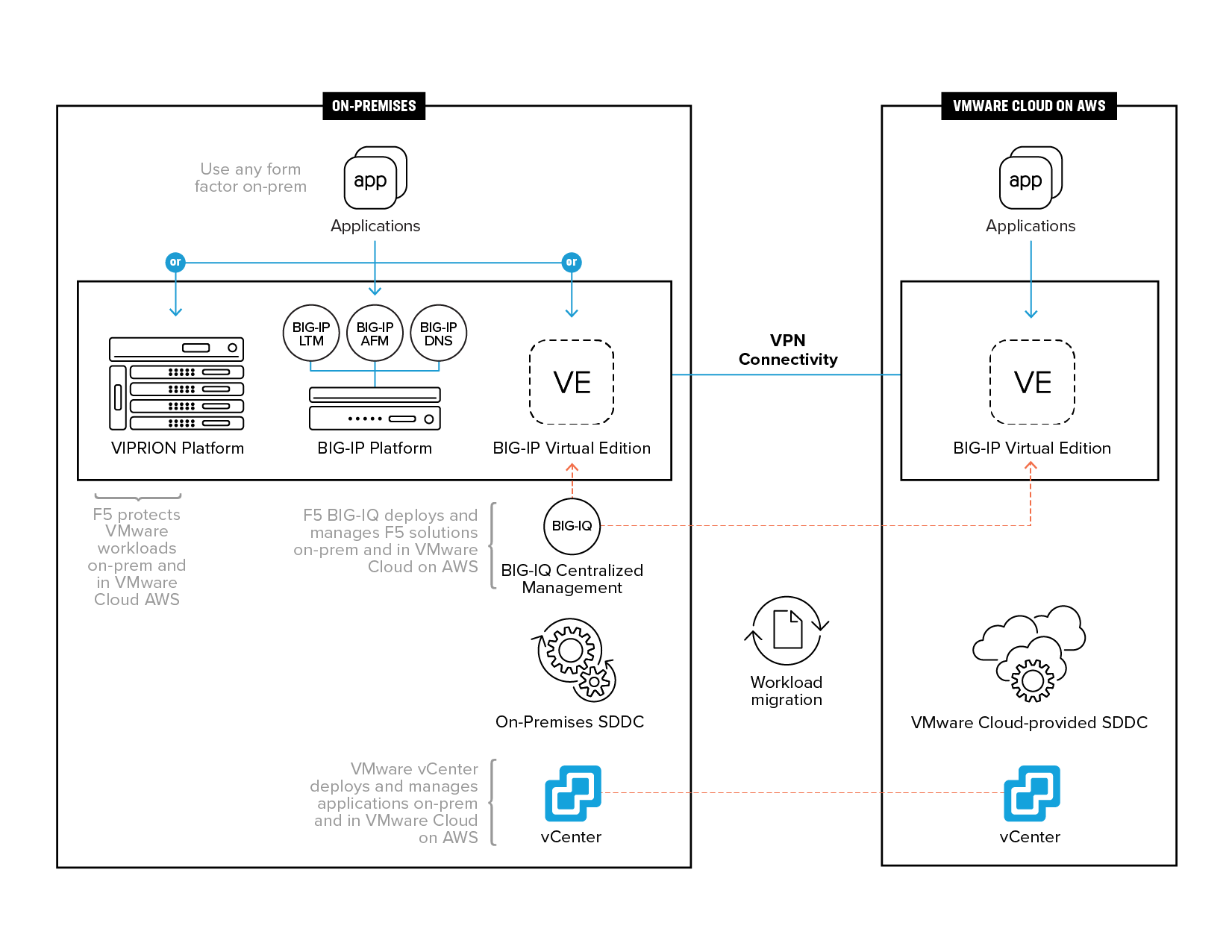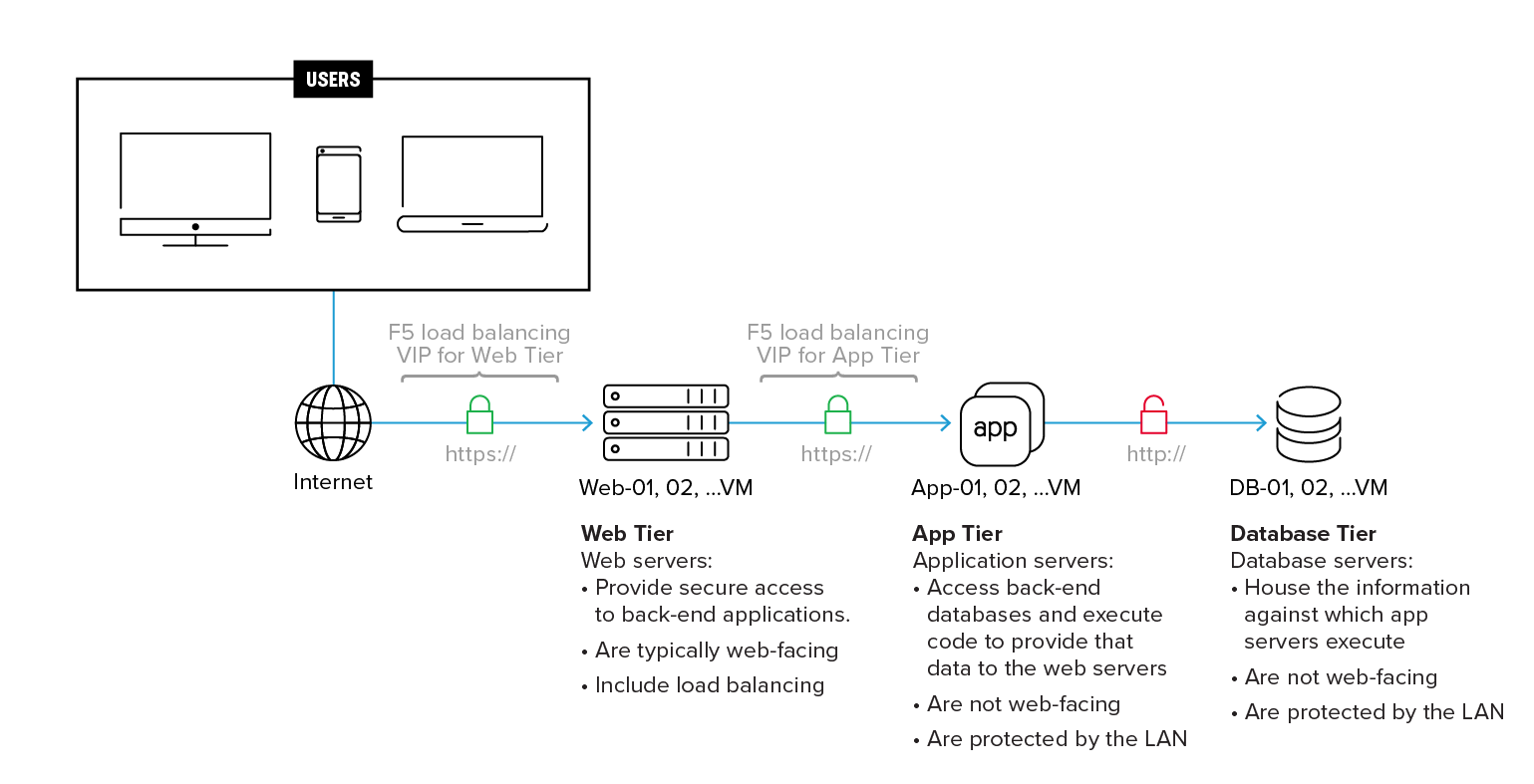AWS에서 VMware Cloud로 워크로드 마이그레이션
온프레미스 데이터 센터에서 Amazon Web Services(AWS)와 같은 퍼블릭 클라우드 공급업체로 작업 부하를 옮기는 데에는 많은 이점이 있는 것으로 알려져 있습니다. 이러한 이점에는 CapEx 감소, OpEx 지출 전반의 예측 가능성 전환, 혁신 가속화, 애플리케이션 배포 속도 향상, 확장성 대폭 향상 등이 있습니다. VMware Cloud 제품 사용자는 AWS에서 VMWare Cloud를 활용해 VMware 환경을 AWS로 확장, 마이그레이션하고 보호하여 원활한 하이브리드 클라우드 환경을 구축할 수 있습니다. AWS에서 구동되는 VMware Cloud는 익숙한 VMware 환경 내에서 다양한 엔터프라이즈급 기능, 간편하고 일관된 운영, 유연한 소비 기능을 제공합니다.
온프레미스 데이터 센터에서 BIG-IP 배포를 감독하는 IT 운영자(온프레미스 위치 내 VMware SDDC(소프트웨어 정의 데이터 센터)의 일부인 워크로드 포함)가 워크로드를 AWS의 VMware Cloud로 마이그레이션해야 할 때 F5에서 의지해 온 귀중한 애플리케이션 서비스를 잃거나 다양한 물리적 및 가상 장치에서 애플리케이션, 서비스 및 구성을 만들고 유지 관리하는 데 이미 투입한 모든 시간을 희생하는 것을 우려할 수 있습니다.
그런 우려는 전혀 근거가 없습니다.
F5와 VMware는 사용자가 보안과 성능을 저하시키지 않고도 전 세계 어디에서나 모든 기기에서 애플리케이션에 액세스할 수 있어야 한다는 비전을 공유합니다. 당사는 다양한 유형의 퍼블릭, 프라이빗 및 하이브리드 클라우드 데이터 센터 플랫폼에서 워크로드가 어디에서 발생하든 일관된 성능을 제공하는 디지털 작업 공간을 지원하기 위해 최선을 다하고 있습니다. 더불어, 우리는 여러분이 한 플랫폼에서 다른 플랫폼으로 쉽고 안전하게 워크로드를 마이그레이션할 수 있도록 모든 도구를 제공합니다.
VMware SDDC가 온프레미스에 있든 VMware Cloud on AWS에 있든 관계없이 vCenter를 사용하여 앱을 배포하고 관리할 수 있으며, 온프레미스에 있든 VMware Cloud on AWS에 있든 동일한 BIG-IP 솔루션을 사용하고 BIG-IQ Centralized Management를 중앙 제어 지점으로 활용하여 클라우드 전반에서 일관된 정책과 절차의 이점을 누릴 수 있습니다.
F5와 VMware 솔루션은 다양한 마이그레이션 옵션을 지원하며(아래의 권장 사항 참조) 모든 중요 구성이 애플리케이션과 데이터와 함께 안전하게 마이그레이션되도록 보장하는 데 도움을 줄 수 있습니다.
IT 관리자의 관점에서 볼 때 VMware SDDC 워크로드가 온프레미스에서 관리되는 방식과 VMware Cloud on AWS에서 관리되는 방식에는 거의 차이가 없습니다. 그림 1에서 볼 수 있듯이:
- F5는 두 환경 모두에서 VMware 워크로드를 보호합니다.
- BIG-IQ Centralized Management는 두 환경 모두에서 워크로드를 배포하고 관리합니다.
- VMware vCenter는 두 환경 모두에 애플리케이션을 배포하고 관리합니다.
또한 BIG-IP를 사용하면 온프레미스 솔루션과 새로운 VMware Cloud on AWS 배포 간에 VPN을 생성하여 SSL을 통해 애플리케이션과 워크로드를 안전하게 마이그레이션할 수 있습니다.

그림 1 : 다중 사이트 참조 아키텍처
워크로드 마이그레이션 과제를 해결하려면 개인 데이터 센터와 클라우드 공급업체를 아우르는 고급 프로그래밍 가능 애플리케이션 전송 서비스가 필요하며, 이를 통해 비즈니스 유연성을 제공하고 성공적인 마이그레이션이 가능합니다. BIG-IP는 사용자가 기존 애플리케이션은 물론, 새로운 클라우드 네이티브 애플리케이션에서도 애플리케이션 서비스와 관련 정책을 일관된 방식으로 애플리케이션 환경 전반에서 제공하고 관리할 수 있는 통합 플랫폼을 제공합니다.
마이그레이션 후 BIG-IP 가상 에디션(VE)은 가속, 최적화, 지능형 트래픽 관리(로컬 및 글로벌)에서 DNS, 고급 애플리케이션 액세스, 네트워크 보안까지 광범위한 지능형 애플리케이션 및 네트워킹 서비스를 제공합니다. 이러한 서비스는 애플리케이션 스택의 일부로 완전히 통합될 수 있으며 자동으로 구성될 수 있습니다. 많은 경우 이러한 서비스는 이미 데이터 센터에 배포되어 있을 가능성이 높으며 VMware Cloud on AWS로 마이그레이션한 후에도 변경되지 않습니다.
온프레미스 데이터 센터와 VMware Cloud on AWS SDDC 간의 가상 머신 마이그레이션인 하이브리드 마이그레이션에 대한 자세한 내용은 VMware에서 확인할 수 있습니다. 하이브리드 마이그레이션 사용 사례에는 가상 머신의 호환성을 보장하기 위한 여러 가지 전제 조건과 구성은 물론, 마이그레이션을 지원하기 위한 적절한 네트워크 대역폭과 지연 시간도 필요합니다. 하이브리드 마이그레이션 사용 사례는 다음과 같습니다.
- 온프레미스 데이터 센터에서 VMware Cloud SDDC로 VMware vMotion을 사용하여 마이그레이션 : 이러한 상황에서는 온프레미스의 한 쌍의 BIG-IP 시스템이 클라우드의 한 쌍의 BIG-IP 시스템과 매칭되어 마이그레이션 내내 vMotion이 활성 상태를 유지하고 애플리케이션이 계속 사용 가능하도록 할 수 있습니다. 각 앱을 마이그레이션하면 관련 BIG-IP 구성도 BIG-IQ Centralized Management를 통해 마이그레이션할 수 있습니다(위의 그림 1 참조).
- 클라우드 SDDC에서 온프레미스 데이터 센터로 vMotion을 사용하여 마이그레이션(일부 제한 있음) : 이는 이전 옵션과 유사하지만, 애플리케이션과 BIG-IP 구성이 반대 방향(클라우드에서 온프레미스로)으로 이동된다는 점이 다릅니다.
- 온프레미스 데이터 센터에서 클라우드 SDDC로, 클라우드 SDDC에서 온프레미스 데이터 센터로의 콜드 마이그레이션 : 이전 시나리오와 달리, 애플리케이션이 한 번에 하나씩 마이그레이션되는 동안에도 사용 중인 반면, 콜드 마이그레이션에서는 마이그레이션하는 동안 애플리케이션을 오프라인으로 전환해야 합니다. 하지만 이 방법을 사용하면 모든 BIG-IP 구성이 포괄적인 단위로 이동되므로 절차가 간소화되고 재구성이 거의 필요하지 않습니다.
- VMware HCX를 사용하여 대량 마이그레이션, vMotion을 통한 마이그레이션, 온프레미스 데이터 센터에서 클라우드 SDDC로의 콜드 마이그레이션 및 다시 돌아오기 : 이전 모든 시나리오와 마찬가지로 양쪽(온프레미스와 클라우드)이 적절하게 구성된 경우 BIG-IQ 중앙 관리를 통해 BIG-IP 정책을 온프레미스와 클라우드 간에 자유롭게 이동하여 애플리케이션과 데이터의 일관성을 유지할 수 있습니다.
대규모 시스템의 경우 일반적으로 앱 서버를 여러 가상 머신으로 확장하는 것이 좋습니다. 이는 그림 2에서 볼 수 있는 것처럼 3계층 설정이 될 수도 있고, 컨테이너화된 마이크로서비스 아키텍처와 같은 다른 애플리케이션 아키텍처가 될 수도 있습니다. AWS에서 VMware Cloud를 사용하는 이점 중 하나는 하이브리드 모빌리티입니다. 즉, 온프레미스와 클라우드 간에 다운타임 없이 워크로드를 이동할 수 있는 기능입니다. 그러나 이러한 마이그레이션 중에 성능이 일시적으로 영향을 받는 것은 드문 일이 아닙니다.

그림 2: 3단계 마이그레이션
AWS의 VMware Cloud와 같은 클라우드 서비스로 애플리케이션 제공 플랫폼을 옮기면 확장성이 즉각적으로 긍정적으로 향상될 수 있습니다. 온프레미스 솔루션의 확장성이 이미 배포된 물리적 리소스에 의해 제한되거나 새 리소스의 배포에 따라 달라지는 경우, AWS의 VMware Cloud SDDC는 가상 리소스를 빠르게 확장하여 끊임없이 변화하는 가상 머신의 요구 사항을 충족할 수 있습니다.
BIG-IP 로컬 트래픽 관리자(LTM)와 BIG-IP 애플리케이션 정책 관리자(APM)는 수천 개의 세션(플랫폼에 따라 다름)을 처리하고 모든 사용자가 언제 어디서나 앱에 액세스할 수 있도록 높은 확장성을 유지하므로 이러한 환경에 이상적입니다. BIG-IP는 또한 지속적인 업그레이드('파기 및 재배포')의 필요성을 줄이고 표준 유지 관리 작업을 줄여 데이터 센터 관련 비용을 줄여줍니다. 이러한 BIG-IP의 이점과 여러 제품의 여러 세션에 걸쳐 높은 가용성을 동시에 제공하는 기능은 온프레미스 또는 AWS의 VMware Cloud에서 통합된 BIG-IP와 VMware SDDC 배포를 따릅니다.
관리의 용이성과 일관성은 사용자가 F5 BIG-IP 시스템과 VMware SDDC를 함께 구축하기로 선택하는 주된 이유 중 하나입니다. 온프레미스 또는 VMware Cloud on AWS에서 F5 BIG-IQ Centralized Management는 F5 솔루션을 배포하고 관리할 수 있으며 VMware vCenter는 SDDC에서 애플리케이션을 배포하고 관리할 수 있습니다. VMware Cloud on AWS로 마이그레이션한 후에는 온프레미스 배포를 위해 원래 설정한 모든 동일한 도구, 프로세스, 절차, 설정 및 구성에 액세스할 수 있습니다.
온프레미스든 AWS의 VMware Cloud든, 애플리케이션은 반드시 보안되어야 합니다. 여러 유형의 볼륨형 DDoS 공격과 앱 계층 공격(OWASP Top Ten, 크로스 사이트 스크립팅, SQL 주입 등)이 결합된 정교하고 혼합된 L3-7 보안 위협으로부터 보호하는 것이 그 어느 때보다 중요해졌습니다. 이러한 위협에 직면했을 때 IT 관리자는 보안 도구의 액세스 및 애플리케이션 보안 정책에 일관성이 있어야 하며, 그렇지 않으면 공격 표면이 의도치 않게 늘어나고 액세스 프로비저닝 및 프로비저닝 해제와 관련된 취약점이 노출되는 일이 없어야 합니다. BIG-IP 솔루션을 사용하면 조직이 프라이빗 데이터 센터와 클라우드 전반에서 일관되고 검증된 보안 정책 및 액세스를 복제하고 시행할 수 있습니다.
마이그레이션 중에 BIG-IP는 온프레미스 솔루션과 새로운 VMware Cloud on AWS 배포 간에 VPN을 만드는 매우 중요한 역할을 합니다. 이런 방식으로, 귀하의 데이터 센터에서 AWS 서버로 전송되는 모든 데이터가 SSL을 통해 완전히 암호화된다는 사실을 확신할 수 있습니다.
기업들이 중요한 애플리케이션을 클라우드로 마이그레이션하는 계획을 수립함에 따라, BIG-IP 플랫폼을 사용하여 애플리케이션을 제공하는 검증된 이점을 클라우드 애플리케이션 워크로드로 쉽게 이식할 수 있습니다. 이를 통해 모든 애플리케이션 인프라에서 일관된 보안을 유지하는 것을 비롯하여 퍼블릭 클라우드 도입과 관련해 사용자가 겪을 수 있는 많은 과제와 우려 사항을 해결할 수 있습니다.
통합된 F5 및 VMware Cloud on AWS 마이그레이션 솔루션은 F5 BIG-IP 애플리케이션 서비스와 BIG-IQ 중앙 관리 기능을 활용하여 위치에 관계없이 VMware SDDC에 중요한 애플리케이션 가용성, 성능 및 보안을 제공합니다. 주요 클라우드 마켓플레이스에서 유연한 라이선스 모델을 제공하므로, 기업은 이러한 서비스를 퍼블릭 클라우드에 계획, 준비 및 배포할 수 있습니다. F5와 VMware는 기업과 조직이 가시성, 보안 및 제어를 유지하면서도 자신 있게 단일 및 멀티 클라우드 환경으로 워크로드를 전환할 수 있도록 지원합니다.